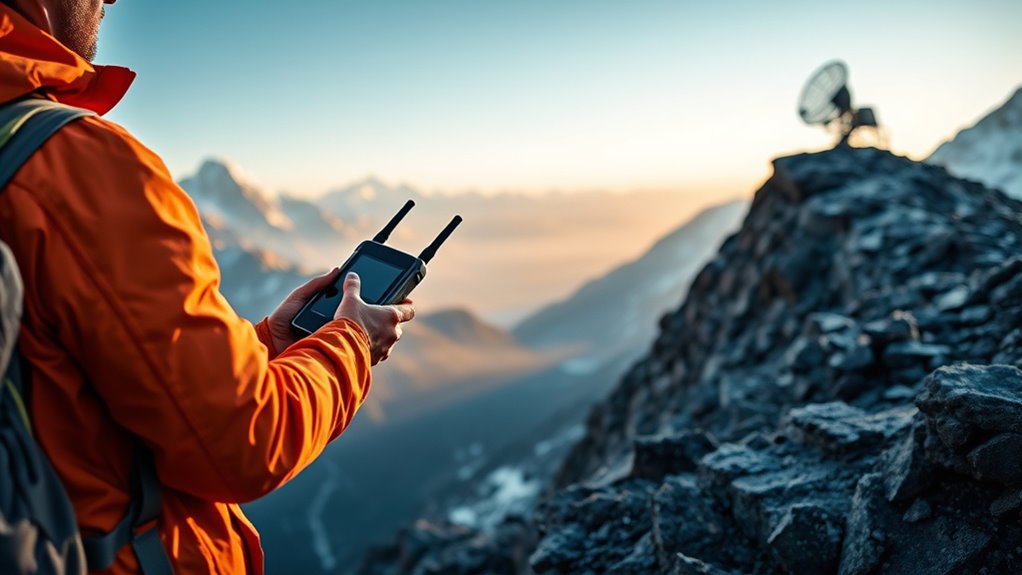If you’re looking for the 15 best two-way satellite communicators of 2025, I’ve got you covered. These devices guarantee reliable global connectivity with features like two-way messaging, SOS alerts, GPS sharing, and rugged durability. They work in remote areas without cell coverage, making them perfect for adventurers, explorers, or professionals in the field. Want to discover which models stand out? Continue on to explore the top options for staying connected anywhere.
Key Takeaways
- The top satellite communicators of 2025 offer two-way messaging, GPS tracking, SOS alerts, and multimedia sharing for reliable global connectivity.
- Devices feature rugged, waterproof designs and long battery life, suitable for harsh outdoor environments and extended remote trips.
- Connectivity is primarily via Iridium or similar satellite networks, often requiring subscription plans for full functionality.
- Many models integrate with smartphones or wearables, providing seamless communication and navigation in off-grid locations.
- These communicators cater to adventurers, remote workers, and emergency responders needing dependable, durable remote communication solutions.
ZOLEO Satellite Communicator for Android and iOS

If you’re looking for a reliable satellite communicator that works seamlessly with your Android or iOS device, the ZOLEO Satellite Communicator is an excellent choice. It offers global two-way messaging via satellite, cellular, Wi-Fi, and Bluetooth, so you stay connected anywhere. With features like GPS location sharing, unlimited check-ins, and emergency SOS alerts, it prioritizes your safety and communication needs. Its rugged, IP68-rated design withstands tough conditions, and the long-lasting battery provides over 200 hours of use. Compact and lightweight, it comes with useful accessories like a carabiner and USB cable, making it perfect for outdoor adventures or remote work.
Best For: outdoor enthusiasts, remote workers, and travelers who need reliable global communication in challenging environments.
Pros:
- Supports two-way messaging via satellite, cellular, Wi-Fi, and Bluetooth for versatile connectivity
- Rugged IP68-rated design withstands harsh conditions and long battery life exceeds 200 hours
- Includes safety features like emergency SOS alerts, GPS location sharing, and accessories for portability
Cons:
- May be relatively expensive compared to basic communication devices
- Requires a compatible smartphone and satellite service subscription for full functionality
- Limited to certain regions depending on satellite coverage and service plans
Garmin inReach Mini 2 Satellite Communicator

The Garmin inReach Mini 2 stands out for outdoor enthusiasts who need a compact, reliable satellite communicator that combines advanced navigation features with easy portability. Weighing just 3.5 ounces and measuring 2.04 x 3.9 x 1.03 inches, it’s perfect for hiking, trekking, or remote adventures. It offers global two-way messaging, interactive SOS, and TracBack routing to retrace your steps. The device connects via Bluetooth to Garmin wearables and supports trip planning through the Garmin Explore app. With water resistance and up to 14 days of battery life, it’s built to handle tough conditions, ensuring dependable communication wherever your adventures take you.
Best For: outdoor enthusiasts, hikers, and adventurers seeking a compact, reliable satellite communicator with advanced navigation and messaging features.
Pros:
- Compact and lightweight design, easy to carry on all outdoor adventures
- Supports global two-way messaging, interactive SOS, and TracBack routing for enhanced safety and navigation
- Water-resistant with up to 14 days of battery life, suitable for tough weather conditions
Cons:
- Requires an active satellite subscription for full functionality
- Limited screen resolution (176 x 176) may affect ease of use in bright or low-light environments
- Connectivity depends on Bluetooth pairing with Garmin devices, which may limit standalone use
Garmin inReach Messenger Handheld Satellite Communicator

Looking for a reliable satellite communicator that’s perfect for outdoor adventurers and professionals alike? The Garmin inReach Messenger is compact, rugged, and lightweight, measuring just 3.1 x 2.5 x 0.9 inches and weighing only 4 ounces. It offers global two-way text messaging via satellite, cellular, and Wi-Fi, ensuring connectivity even in remote areas. With a rechargeable battery lasting up to 28 days in tracking mode, safety features like interactive SOS alerts, GPS location sharing, and preset check-ins, it prioritizes safety. Compatible with Garmin devices and supporting various networks, it’s a versatile, dependable tool for staying connected anywhere.
Best For: outdoor adventurers, professionals, and anyone needing reliable, global communication in remote areas.
Pros:
- Compact, rugged, and lightweight design for portability and durability
- Supports global two-way messaging via satellite, cellular, and Wi-Fi networks
- Long battery life of up to 28 days in tracking mode with safety charging features
Cons:
- Requires an active satellite subscription for full functionality
- May be regulated or restricted in certain jurisdictions
- Limited display resolution of 160 x 68 pixels may impact user interface visibility
Garmin inReach Mini 2 Satellite Communicator

For outdoor enthusiasts seeking a lightweight, durable satellite communicator, the Garmin inReach Mini 2 stands out with its compact design and reliable global coverage. Weighing just 3.5 ounces and measuring 4 inches by 2 inches, it’s built tough to meet MIL-STD-810 standards and is IPX7 water-resistant. Despite its small size, it offers impressive battery life—up to 14 days in default mode, or 30 days with extended tracking intervals. It features a clear 0.9-inch display, voice commands, and seamless integration with Garmin’s Explore app. With global Iridium satellite coverage, it supports two-way messaging, emergency SOS, navigation, and weather updates, making it a versatile, essential tool for any adventure.
Best For: outdoor enthusiasts and explorers seeking a lightweight, durable satellite communicator for reliable global messaging, navigation, and emergency rescue capabilities.
Pros:
- Compact, rugged design meeting MIL-STD-810 standards and IPX7 water resistance
- Long battery life of up to 14 days in default mode and 30 days with extended tracking
- Seamless integration with Garmin Explore app and compatible Garmin devices for planning and remote control
Cons:
- Slightly higher price point compared to simpler GPS devices
- Limited display size may restrict detailed map viewing
- Subscription plans required for satellite communication services
Spot X with Bluetooth 2-Way Satellite Messenger
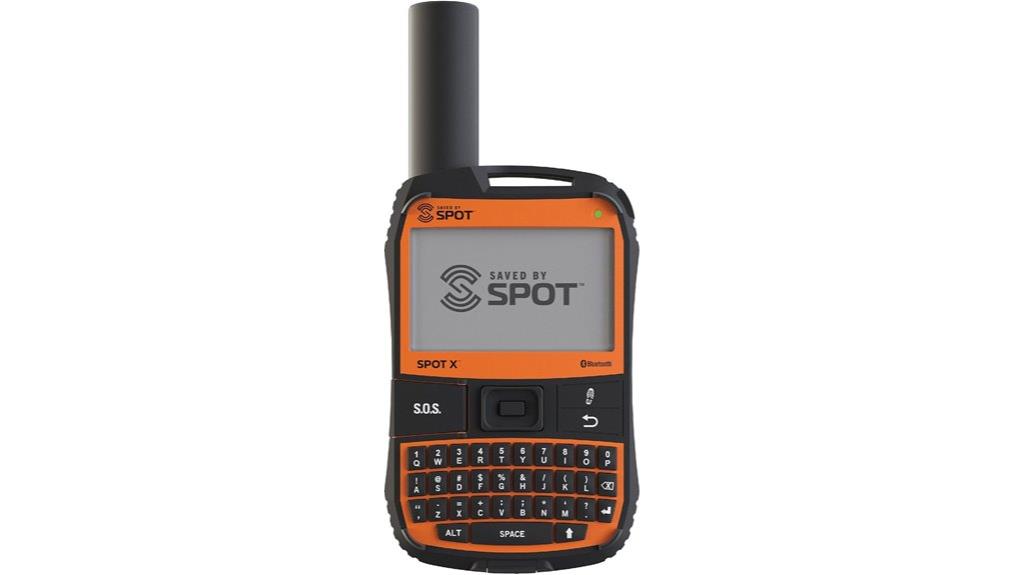
Outdoor enthusiasts who need reliable communication in remote areas will appreciate the Spot X with Bluetooth 2-Way Satellite Messenger, especially since it supports global coverage and functions independently of smartphones. This device offers SOS protection and serves as a portable, standalone GPS messaging tool with its own US mobile number, making it easy to send and receive messages without pairing to a phone. Its Bluetooth connectivity works with Android and iOS apps, adding convenience. Weighing just 7 ounces, it’s durable and compact, perfect for hiking, camping, or driving in remote regions. With subscription plans and solid user ratings, the Spot X stands out as a dependable choice for staying connected anywhere.
Best For: outdoor enthusiasts, hikers, campers, and travelers who need reliable, standalone satellite communication in remote areas without smartphone dependence.
Pros:
- Supports global coverage via the Globalstar Satellite Network for reliable connectivity worldwide
- Functions as a standalone GPS messaging device with its own US mobile number, enabling direct message sending and receiving without pairing to a smartphone
- Compact, lightweight (7 ounces), and durable, making it ideal for outdoor adventures
Cons:
- Subscription-based service may incur ongoing costs for users
- Customer rating of 3.9 out of 5 stars suggests some users may experience issues or limitations
- Limited to satellite communication, so it may not be suitable for everyday cellular needs
Motorola Defy Satellite Link Rugged GPS Communicator
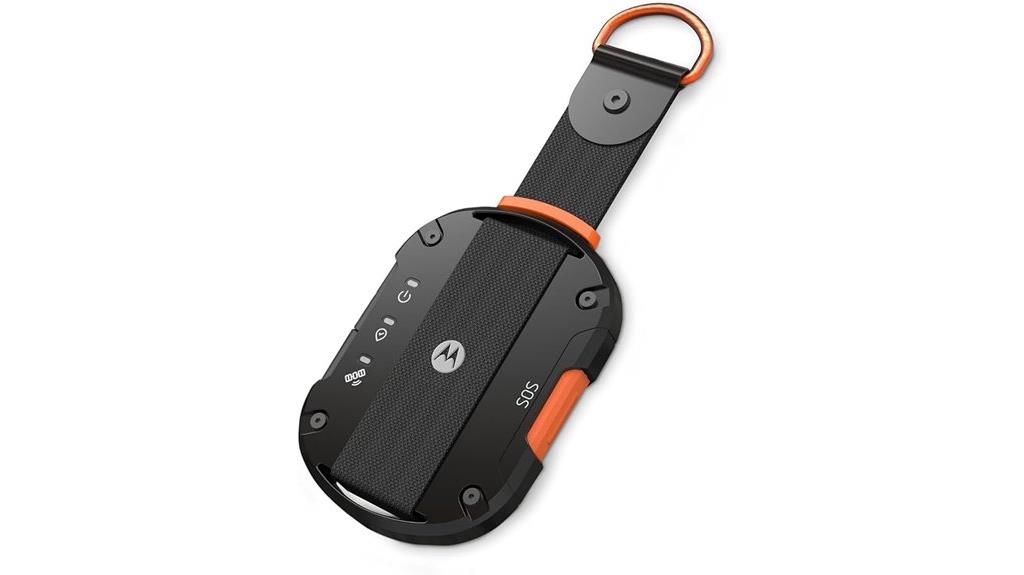
The Motorola Defy Satellite Link stands out as an ideal choice for adventurers and remote workers who need dependable off-grid communication. It transforms smartphones into satellite-enabled devices via Bluetooth, compatible with iOS 14+ and Android 10+. With its rugged design, it’s built for tough environments, weighing just 2.5 ounces. The device offers advanced 2-way satellite messaging, including global SMS and emergency SOS alerts, ensuring you stay connected anywhere. You can send your location or check in, even without cellular coverage. Service plans start at $4.99/month, providing reliable coverage and peace of mind during your adventures or remote work.
Best For: off-grid adventurers, remote workers, and emergency responders who need reliable satellite communication in tough environments.
Pros:
- Transforms smartphones into satellite-enabled communicators via Bluetooth for seamless connectivity.
- Rugged design built for durability in challenging environments.
- Affordable service plans starting at $4.99/month with comprehensive 2-way messaging and SOS alerts.
Cons:
- Customer ratings are moderate, with some users reporting issues or limited satisfaction.
- Compatibility requires devices to run iOS 14+ or Android 10+, which may exclude older smartphones.
- Price and availability can vary, and ongoing service costs may add up over time.
Garmin inReach Messenger Plus SOS Satellite Communicator

If you need a reliable device that keeps you connected in remote areas, the Garmin inReach Messenger Plus SOS satellite communicator is an excellent choice. It offers two-way text, photo, and voice messaging without cell service, connecting seamlessly via Garmin Messenger app to your smartphone. You can send messages up to 1,600 characters, share photos, and trigger SOS alerts directly from the device, which connects with Garmin watches and handhelds for remote control. With a long battery life supporting up to 25 days, durable IPX7 water resistance, and multi-network connectivity, it guarantees safety and communication wherever your adventures take you.
Best For: outdoor enthusiasts, adventurers, and travelers who need reliable communication and emergency SOS capabilities in remote areas without cell service.
Pros:
- Supports two-way text, photo, and voice messaging via satellite, ensuring connectivity in remote locations
- Long battery life of up to 25 days, ideal for extended trips
- Durable, water-resistant (IPX7) design suitable for rugged outdoor environments
Cons:
- Requires an active subscription, which can incur ongoing costs
- Limited to 1,600-character messages, which may restrict detailed communication
- May be regulated or restricted in certain jurisdictions due to satellite device regulations
Wearable4U Garmin inReach Mini 2 Satellite Communicator with Power Pack Bundle

For adventurers and travelers who need reliable communication in remote areas, the Wearable4U Garmin inReach Mini 2 Satellite Communicator with Power Pack Bundle stands out as an excellent choice. It offers global two-way messaging, interactive SOS, and navigation with TracBack routing. You can share your location via MapShare or embedded coordinates, and the digital compass provides accurate heading info even when stationary. The bundle includes a Power Bank and chargers to keep the device powered during long trips. With up to 30 days of battery life and compatibility with Garmin wearables, it’s perfect for outdoor enthusiasts seeking dependable connectivity everywhere.
Best For: outdoor adventurers, hikers, and travelers who need reliable global communication and navigation in remote areas.
Pros:
- Offers global two-way messaging, interactive SOS, and detailed navigation features including TracBack routing.
- Comes with a Power Bank and chargers, ensuring extended use during long outdoor activities.
- Compatible with Garmin wearables and handhelds, allowing seamless integration for messaging and safety.
Cons:
- Slightly heavier at 1.04 pounds, which may be a consideration for ultra-light backpackers.
- Battery life is up to 30 days in standby mode, but active tracking modes may drain power faster.
- The device’s size and display might be less suitable for those preferring ultra-compact or minimal gear.
HMD OffGrid Satellite Communicator

Designed for outdoor enthusiasts and adventurers, the HMD OffGrid Satellite Communicator offers reliable two-way messaging even in the most remote areas. It supports real-time location sharing, check-in messages, and SOS alerts to summon help quickly. Built with military-grade durability, it withstands harsh environments, is waterproof, and weighs just over two ounces. The device connects seamlessly to Android and iOS via Bluetooth, making setup straightforward. With a three-day battery life and compact design, it’s perfect for off-grid adventures. Whether you’re exploring wilderness or remote terrains, the HMD OffGrid keeps you connected and safe, giving peace of mind wherever your journey takes you.
Best For: outdoor enthusiasts and adventurers seeking reliable off-grid communication in remote environments.
Pros:
- Durable, military-grade construction that withstands harsh conditions
- Compact and lightweight design for easy portability
- Supports real-time location sharing, check-in, and SOS alerts via satellite
Cons:
- Customer reviews indicate mixed satisfaction, averaging 2.4 stars
- Limited to satellite connectivity, which may have coverage gaps in some areas
- Requires a compatible smartphone and subscription plan for operation
Garmin inReach Messenger Handheld Satellite Communicator

The Garmin inReach Messenger Handheld Satellite Communicator stands out as an excellent choice for outdoor enthusiasts who need reliable two-way messaging in remote areas. It’s lightweight at just 4 ounces and compact, making it easy to carry on adventures. This device enables global text messaging, group chats, and check-ins without cell coverage, using an active satellite subscription. It also features GPS location sharing and an interactive SOS button for emergencies. Renewed and tested to look and work like new, it comes with a 90-day warranty, ensuring quality and peace of mind. Perfect for remote trips, it keeps you connected and safe wherever your adventures take you.
Best For: outdoor enthusiasts and adventurers who need reliable two-way satellite communication in remote areas without cell service.
Pros:
- Compact, lightweight design weighing only 4 ounces, easy to carry on outdoor trips.
- Enables global two-way text messaging, group chats, and check-ins without cell coverage.
- Includes an interactive SOS feature for emergency assistance, ensuring safety in remote locations.
Cons:
- Requires an active satellite subscription to access messaging, location sharing, and SOS functions.
- Some jurisdictions may regulate or restrict the use of satellite communication devices.
- Pre-owned or refurbished condition may vary, though inspected and tested to look and work like new.
Wearable4U Garmin inReach Messenger Satellite Communicator
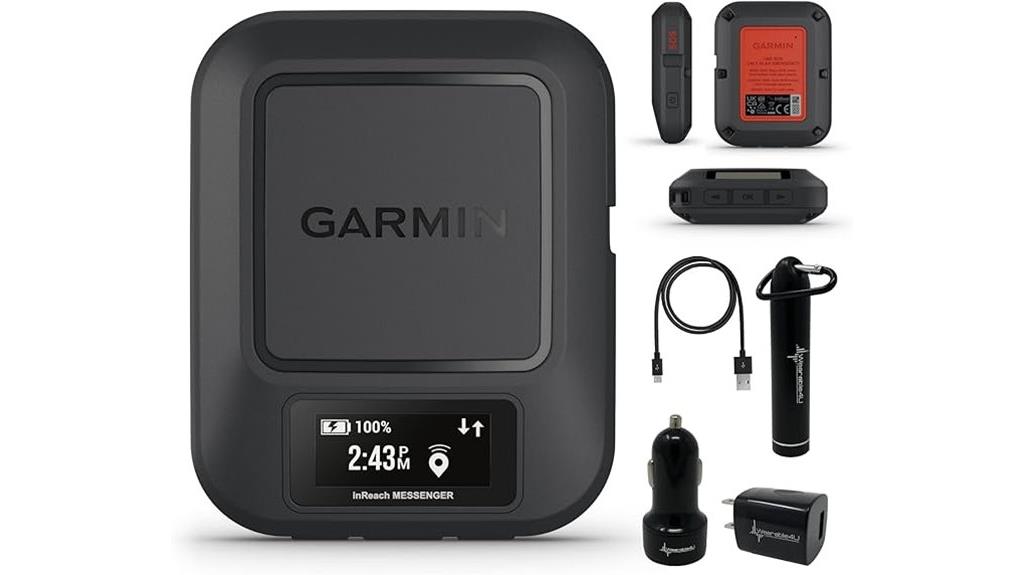
If you need a reliable satellite communicator that keeps you connected in remote areas without cellular coverage, the Wearable4U Garmin inReach Messenger is an excellent choice. Its compact, rugged design makes it perfect for outdoor adventures, weighing just about 1.08 pounds. It offers global two-way text messaging through the Garmin Messenger app, supporting quick check-ins and group chats. The device’s internal rechargeable battery lasts up to 28 days in tracking mode, and the bundle includes a portable power bank to keep everything charged. With a 1.08-inch display and voice command buttons, it’s user-friendly and durable, ensuring you stay connected and safe wherever your journey takes you.
Best For: outdoor enthusiasts, hikers, and travelers who need reliable satellite communication in remote areas without cellular coverage.
Pros:
- Compact, rugged, and lightweight design ideal for outdoor adventures
- Supports global two-way text messaging and group chats via Garmin Messenger app
- Long-lasting rechargeable battery lasts up to 28 days in tracking mode
Cons:
- Requires an active satellite subscription for full functionality
- Some jurisdictions may regulate the use of satellite communication devices
- Price may be higher compared to basic GPS or messaging devices
Garmin GPSMAP 67i Rugged GPS Handheld with inReach® Satellite Technology
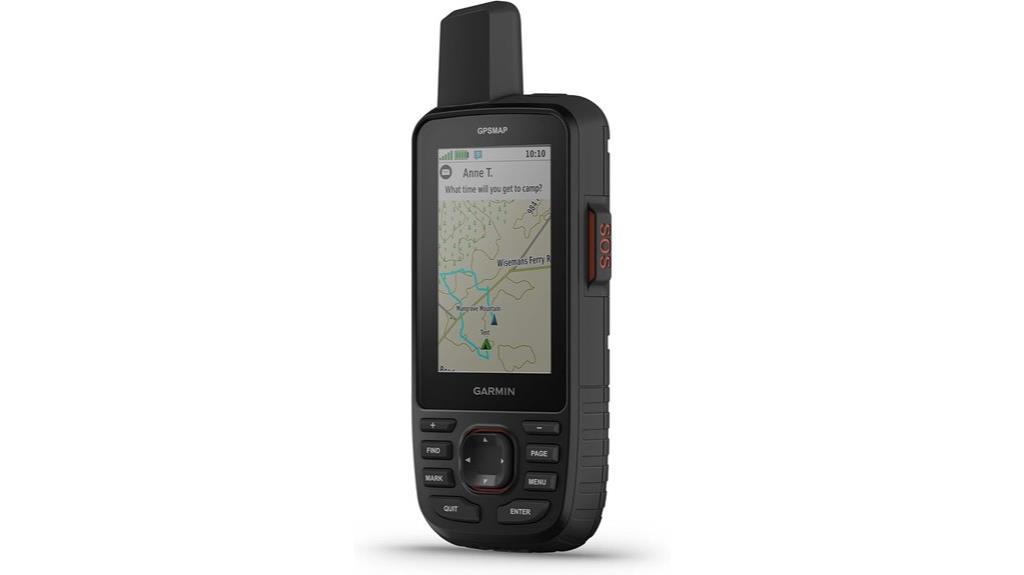
For outdoor enthusiasts who need reliable communication and navigation in remote areas, the Garmin GPSMAP 67i Rugged GPS Handheld with inReach® satellite technology stands out as an excellent choice. Its durable design, lightweight build, and 3-inch sunlight-readable display make it perfect for tough environments. The device offers two-way messaging, global Iridium satellite coverage, and an interactive SOS connected to Garmin Response℠ for emergencies. With preloaded topo maps, satellite imagery, and multi-band GNSS support, it guarantees confident navigation. Bluetooth, Wi-Fi, and USB connectivity add to its versatility, making this handheld a dependable companion for any outdoor adventure.
Best For: outdoor adventurers and explorers who need reliable navigation and communication in remote, rugged environments.
Pros:
- Durable, lightweight design with a bright 3-inch sunlight-readable display for easy outdoor use
- Global Iridium satellite coverage enabling two-way messaging and emergency SOS with Garmin Response℠
- Preloaded topo maps, satellite imagery, and multi-band GNSS support for confident navigation
Cons:
- Subscription required for certain features like Garmin Response℠ and premium maps
- Price and availability may vary, potentially making it a higher initial investment
- Limited to physical buttons for human interface, which may require some getting used to for navigation
Garmin inReach Mini 2 Satellite Communicator

As a compact and rugged device, the Garmin inReach Mini 2 stands out for outdoor enthusiasts who need reliable global communication in remote areas. Its small size—just 4 inches by 2 inches—and lightweight design at 3.5 ounces make it easy to carry on any adventure. Built to meet MIL-STD-810 standards and with an IPX7 water resistance rating, it’s durable enough for harsh conditions. It offers global coverage via the Iridium satellite network, supporting two-way messaging, SOS alerts, and email. With up to 14 days of battery life, weather updates, and seamless integration with Garmin apps, it’s a reliable companion for safety and communication.
Best For: outdoor enthusiasts and adventurers who need reliable global communication and safety features in remote areas with no cell coverage.
Pros:
- Compact, lightweight, and rugged design suitable for harsh outdoor conditions
- Global coverage with Iridium satellite network for two-way messaging and SOS alerts
- Long battery life up to 14 days in default tracking mode with weather updates support
Cons:
- Higher subscription cost compared to traditional cell-based communication devices
- Limited display size may restrict detailed map viewing and navigation
- Requires a satellite plan, which may not be ideal for casual or infrequent users
Garmin inReach® Mini 2 Marine Bundle, Portable Satellite Communicator
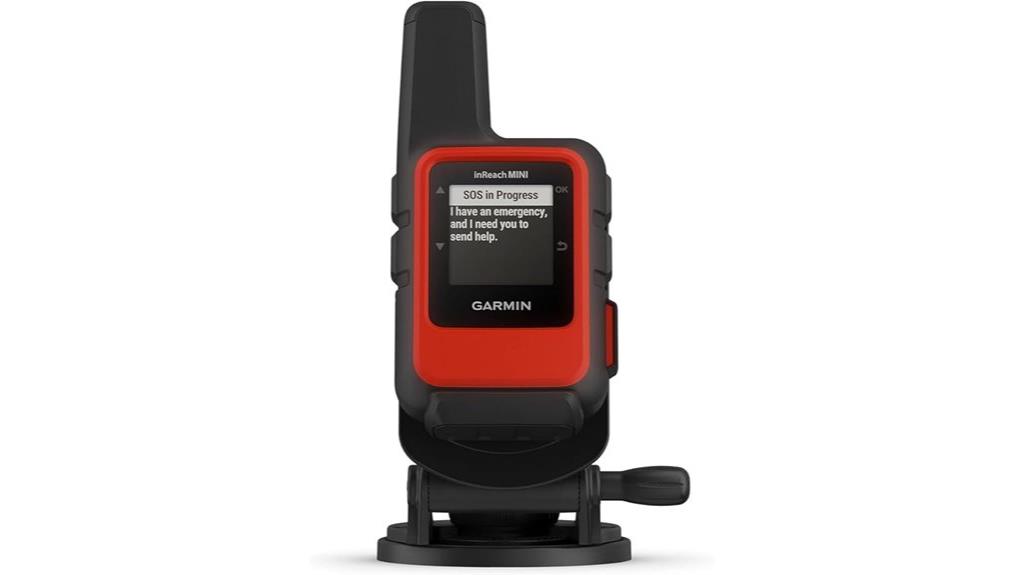
The Garmin inReach® Mini 2 Marine Bundle stands out as an ideal choice for boaters and outdoor enthusiasts who need reliable, compact satellite communication. Its lightweight design makes it easy to carry and mount at the helm for quick access. It offers global two-way messaging, interactive SOS, and navigation features like a digital compass. The device syncs seamlessly with the Garmin Explore app, allowing for trip planning, waypoint management, and route logging. Wirelessly pairing with compatible Garmin devices enhances functionality, while accessories like mounts and flotation lanyards ensure durability and ease of use. It’s a versatile tool for staying connected in remote or marine environments.
Best For: boaters and outdoor adventurers seeking a reliable, compact satellite communication device for remote locations and marine environments.
Pros:
- Compact and lightweight design for easy portability and quick mounting at the helm
- Seamless integration with Garmin Explore app for trip planning and route management
- Supports two-way messaging, interactive SOS, and navigation features like a digital compass
Cons:
- Requires an active satellite subscription for messaging and SOS services
- Legal restrictions may apply depending on jurisdiction, requiring user awareness and compliance
- Limited to Garmin-compatible devices for wireless pairing and enhanced functionality
Garmin inReach Mini Handheld Satellite Communicator (Renewed)

If you need a compact and reliable satellite communicator to stay connected in remote areas, the Garmin inReach Mini Handheld Satellite Communicator (Renewed) is an excellent choice. Weighing just 3.52 ounces and measuring 2 x 3 x 4 inches, it’s easy to carry anywhere. It offers two-way text messaging via the Iridium satellite network, with interactive SOS alerts to rescue centers for safety. The device supports mapping, weather updates, and seamless connectivity with Garmin wearables. Its long battery life—up to 24 days with 2 AA batteries—ensures you’re covered on extended trips. Backed by a 90-day warranty, it’s a dependable option for outdoor adventurers.
Best For: outdoor enthusiasts, hikers, and adventurers who need reliable satellite communication in remote areas.
Pros:
- Compact and lightweight design weighing only 3.52 ounces for easy portability.
- Up to 24 days of battery life with 2 AA batteries, ideal for extended trips.
- Supports two-way messaging, interactive SOS alerts, and seamless connectivity with Garmin devices.
Cons:
- Subscription required for satellite messaging and SOS services, adding ongoing costs.
- Limited display size (1.27 inches), which may be small for some users.
- Not suitable for areas outside the Iridium satellite coverage or in jurisdictions with legal restrictions.
Factors to Consider When Choosing Two‑Way Satellite Communicators

When selecting a two-way satellite communicator, I consider factors like coverage area and device durability to guarantee it meets my needs in remote locations. Battery life and connectivity options also matter, so I can stay connected without constant recharging or signal issues. Finally, I look at messaging and SOS features to make sure I’m prepared for emergencies and everyday communication.
Coverage Area Compatibility
Choosing a two-way satellite communicator requires careful attention to coverage area compatibility, as not all devices support the same networks or regions. I recommend verifying that the device supports the satellite network coverage for your intended area, whether it’s Iridium, Globalstar, or Thuraya, since each has different global reach. It is crucial to confirm if the device offers truly global coverage, especially in remote or polar regions where some networks have limited service. Additionally, check if the device complies with local regulations, as satellite use can be restricted or regulated in certain countries. Consider whether the coverage extends inland or is primarily offshore, depending on your activities. Ensuring your communicator’s coverage matches your travel zones prevents dead zones and service gaps during critical moments.
Battery Life Duration
Battery life is a key factor to contemplate after confirming your device’s coverage area, as reliable communication depends on having power throughout your outdoor adventures. Longer battery life ensures you stay connected during extended trips without frequent recharging. Devices with at least 14 days of battery life are ideal for multi-day excursions in remote areas, providing peace of mind. Keep in mind that battery performance varies with usage, such as messaging frequency and GPS tracking. Rechargeable lithium-ion batteries generally outperform disposable ones, offering better durability and longer life. Some communicators include power-saving modes or extended battery options to maximize operational time in the field. Selecting a device with robust battery life guarantees you won’t be left stranded, even during prolonged periods of limited access to power sources.
Device Durability Standards
Durability standards are crucial to contemplate because they directly impact a device’s ability to perform reliably in tough conditions. Devices with military-grade standards are designed to withstand harsh environments, including water, dust, and shock. An IP68 or IPX7 rating ensures water resistance, meaning the device stays functional after immersion. Compliance with MIL-STD-810 standards indicates resistance to extreme temperatures, vibration, and shocks, which are common during rugged outdoor activities. Durability certifications often include drop protection, dust ingress, and temperature extremes tests, critical for off-grid use. Choosing a device with high durability standards guarantees reliability and longevity when repairs or replacements are difficult. This resilience is essential for maintaining connectivity and safety in remote, challenging environments.
Messaging and SOS Features
When selecting a two-way satellite communicator, it’s essential to guarantee it supports reliable messaging and emergency features. Look for devices that enable two-way messaging via satellite, cellular, or Wi-Fi, ensuring you can stay connected in remote areas. An interactive SOS feature is critical—it should trigger emergency assistance and connect you to monitoring centers 24/7. Check if the device offers preset messages or check-in options to save time during urgent situations. Additionally, consider if it allows email or social media sharing, broadening your communication beyond simple texts. Finally, review messaging plan options, like unlimited messaging or message limits, to match your usage needs and budget. Reliable messaging and SOS features are vital for safety and staying connected anywhere you go.
Connectivity Options Available
Choosing the right connectivity options is crucial for guaranteeing reliable communication in remote areas. Most two-way satellite communicators connect via the Iridium network, offering global coverage where cellular signals are unavailable. Many devices also support multiple options like cellular, Wi-Fi, and Bluetooth, which boost versatility and convenience. Some models automatically switch between satellite, cellular, and Wi-Fi networks, helping maintain continuous contact. Bluetooth connectivity allows pairing with smartphones, tablets, or Garmin devices, enabling messaging, navigation, and remote control functions. When selecting a device, consider how different connectivity methods align with your needs, as they influence coverage, reliability, and costs. Balancing these options ensures you’re prepared for various environments, reducing communication gaps during your adventures or remote work.
Ease of Use
Selecting a satellite communicator that’s easy to use can make all the difference in critical moments. An intuitive interface with simple controls and clearly labeled buttons helps prevent confusion when every second counts. A large, high-contrast display guarantees readability in bright sunlight or low-light conditions, making operation straightforward. Voice command features allow hands-free use, which is especially useful during outdoor activities or emergencies. Seamless switching between satellite, cellular, Wi-Fi, and Bluetooth connections reduces the effort needed to maintain communication, keeping you connected effortlessly. Clear instructions and quick access to emergency functions are essential, enabling rapid response when time is of the essence. Overall, a user-friendly design minimizes frustration and enhances confidence during your most demanding situations.
Subscription Plans Cost
Understanding the different subscription plans available is essential to getting the most value from your two-way satellite communicator. Plans vary widely, with options like monthly, annual, or pay-as-you-go, affecting both cost and flexibility. Prices can range from as low as $4.99 per month to over $50, depending on data limits and included features. Higher-cost plans often include unlimited messaging, better emergency services, and additional navigation or tracking tools. Some providers charge activation fees or require minimum commitments, which can increase total expenses over time. It’s important to analyze your usage needs and compare plans carefully. Selecting a plan that matches your communication habits ensures you get the best value without overspending. This approach helps you stay connected reliably without unnecessary costs.
Size and Portability
The size and portability of a satellite communicator are essential factors that can make or break your outdoor experience. Compact devices weighing under 4 ounces are ideal for backpackers and adventurers, as they’re easier to carry, store, and handle in remote environments. Smaller devices often feature streamlined designs, fitting comfortably in pockets or clipped onto gear, which enhances convenience during extended activities. While larger models may have bigger screens and extra buttons, they tend to compromise on ease of transport and usability on the go. The device’s dimensions—including length, width, and thickness—play a critical role in portability. Ultimately, choosing a lightweight, compact communicator ensures it won’t hinder your mobility or comfort, making it a reliable companion for your adventures.
Frequently Asked Questions
What Security Features Do These Satellite Communicators Offer?
These satellite communicators come with superior security features like end-to-end encryption, ensuring your messages stay private. I appreciate their multi-layered security protocols, including secure login and data protection measures, which guard against hacking and interception. Many also offer remote device wiping and automatic alerts for suspicious activity. Overall, I feel confident using these devices, knowing they prioritize my safety and privacy in every communication.
How Do Battery Life and Charging Options Compare Among Models?
Oh, battery life and charging options? Well, it’s a wild ride. Some models last days on a single charge, perfect for remote adventures, while others need daily juice. Charging methods vary from solar panels to USB-C, making recharging a breeze or a chore. Honestly, I’d say pick one that matches your trip—because nothing says “reliable” like a satellite communicator that’s ready when you are, no matter how long you’re off-grid.
Are These Devices Compatible With Existing Emergency Services Networks?
Yes, most of these satellite communicators are compatible with existing emergency services networks. I’ve found that many models integrate seamlessly with popular emergency platforms, allowing quick access during crises. However, I always recommend checking the specific device’s specifications to verify compatibility with your local emergency systems. Staying prepared means knowing your device’s capabilities, so I suggest reviewing compatibility details before making a purchase.
What Are the Costs of Service Plans for Global Coverage?
Service plan costs for global coverage vary depending on the provider and usage needs. I’ve seen plans start around $50 per month for basic coverage, which is suitable for occasional use. More extensive plans with unlimited data or priority access can range up to $150 or more monthly. It’s best to compare providers, consider your usage patterns, and choose a plan that balances cost and coverage for your specific needs.
How Durable Are These Devices in Extreme Weather Conditions?
Imagine a sturdy ship braving rough seas—that’s how durable these devices are in extreme weather. I’ve found that top models are built with rugged materials and reinforced casings, making them resistant to rain, snow, and even dust storms. While no device is completely indestructible, these communicators are designed to withstand harsh conditions, ensuring I stay connected no matter how stormy the weather gets.
Conclusion
Choosing the right two-way satellite communicator is like finding a reliable compass in uncharted territory. With options like ZOLEO, Garmin, and Spot X, you can stay connected no matter where adventure takes you. Think of it as having a lifeline woven with technology, ensuring you’re never truly lost. So, pick the one that fits your needs, and embrace worry-free exploration—because reliable connectivity is your best travel companion.
